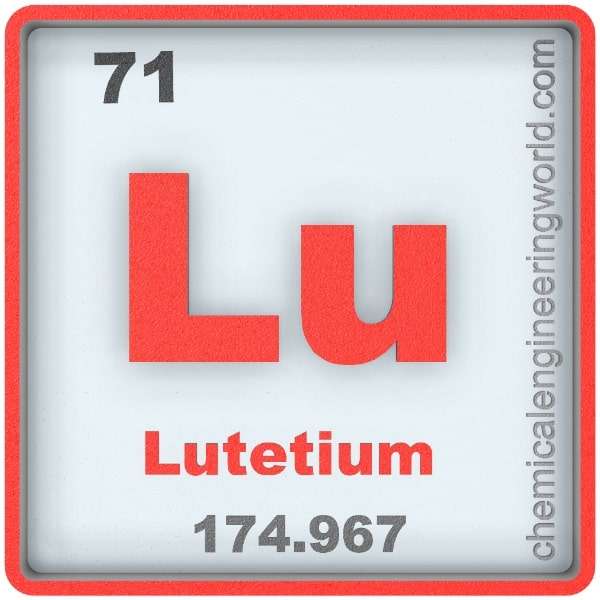Lutetium Element Properties and Information

Lutetium Element Properties and Information
Lutetium is 71st element on the periodic table. Elements are arranged in the periodic table on the basis of the atomic number. Atomic number is the number of protons in the nucleus of the atom. Lutetium has an atomic number of 71. It is located in the Group ‘Lanthanides’ and Period 6 of the periodic table of elements. It is denoted by ‘Lu’. It is derived from the roman name for Paris, Lutetia.
The story of discovery of lanthanides is that when the Yttrium was discovered in 1794, it was thought to be a pure element but as time passed scientists began to question its purity and reasoned that there must be more elements to separate from it. Many elements of similar chemical properties were separated from the contaminated yttrium; first one was Erbium and the last element to be separated was Lutetium. Georges Urbain in Paris, France and Charles James in New Hampshire, USA are independently credited to be discoverers of lutetium.
Lutetium never appears in nature as a free element. Its concentration in Earth’s crust is 0.5 ppm. It is extracted along with other lanthanides and its principle source is monazite mineral. The concentration of lutetium in monazite minerals is about 1 ppm.
Physical Properties
- Lutetium is a hard & dense metal which has silvery appearance. It is the last element in the lanthanide series.
- The atomic mass of lutetium is 174.97.
- The melting point of lutetium is 1663°C.
- The boiling point of lutetium is 3395°C.
- The density of lutetium is 9700 in S.I. units at 20°C.
- Lutetium possesses highest hardness, density, and melting point compared to other lanthanides.
- Lutetium occurs in nature as two isotopes; lutetium-175 and lutetium-176. Lutetium-175 is stable and lutetium-176 is radioactive.
Chemical Properties
- Lutetium resists corrosion in presence of dry air but begins to tarnish when exposed to moist air.
- Lutetium compounds exhibit +3 oxidation state.
- Lutetium burns readily to form lutetium oxide at 150°C.
- Lutetium reacts to form acetates, sulfates, fluoride, oxide, hydroxide, oxalate, carbonate, phosphate, etc.
- Lutetium hydroxide is formed when lutetium reacts with water. The reaction is slow when water is cold and fast when water is hot.
- Lutetium metal reacts with all halogens to form trihalides. Among them, only the fluoride dissolves in water.
Methods of Production
Ion-Exchange & Reduction: The monazite mineral is crushed and dissolved into sulphuric acid. The sulphates of the lanthanides are then converted to oxalates then to oxides then to double-salts. Ion-exchange method is used to separate ytterbium from other lanthanides. Lastly, alkali metals or alkaline earth metals are used to reduce lutetium fluoride or lutetium chloride to obtain lutetium in metallic form.
Relevance in Chemical and Related Industries
Catalysts: Lutetium is used in petroleum-cracking, polymerization, hydrogenation, and alkylation processes.
Relevance in Other Industries
- Dopant: Magnetic bubble memory devices use lutetium-doped gadolinium gallium garnet to function. Lutetium aluminum garnet can be used as lens material in application of high refractive-index immersion lithiography, it is also used as a phosphor material in LED light bulbs.
- Detector: The preferred compound for detectors in positive emission tomography (PET) is cerium-doped lutetium oxyorthosilicate.
- Radioactive-isotopes applications: Lutetium-176 is used as a pure-beta emitter and also in meteorite dating. The synthetic isotope, lutetium-177 finds its use in radionuclide therapy.
Health Effects on Exposure
- Toxicity: Insoluble salts of lutetium are non-toxic on ingestion but lutetium itself and the soluble salts of lutetium are mildly toxic. Some lutetium compounds are highly toxic hence they must be handled with care.
- Hazard: Lutetium dusts are potential fire hazard. They can cause severe burns if ignited accidentally at work place.
Effects on Surroun
Lutetium poses no harm to plants and animals.
References:
https://en.wikipedia.org/wiki/Lutetium
https://www.lenntech.com/periodic/elements/lu.htm
https://www.rsc.org/periodic-table/element/71/lutetium
































